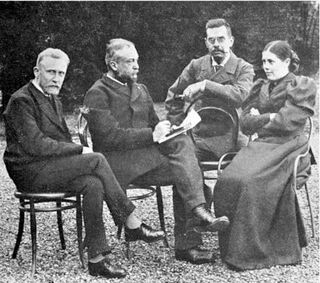Deception
Lying and Pseudologia Fantastica
A brief review of the rare psychiatric syndrome.
Posted February 14, 2021 Reviewed by Devon Frye
All pathological liars have a purpose, i.e., to decorate their own person, to tell something interesting, and an ego motive is always present. They all lie about something they wish to possess or be (Healy & Healy, 1915, p. 16).
Lying is a common human phenomenon in which a person seeks to deceive to avoid harmful or uncomfortable consequences. In pseudologia fantastica, a pathological form of lying, the patient lies not to avoid painful consequences but rather to obtain internal reward or gratification.

First described by the German psychiatrist Anton Delbrük in 1891, pseudologia fantastica has been conceptualized both as a distinct psychiatric disorder and as a symptom of personality disorder. DSM-5 considers the syndrome to be a feature of narcissistic, antisocial, and histrionic character pathologies, or as a form of factitious disorder (American Psychiatric Association, 2013).
While it may be difficult for the psychotherapist or psychiatrist to detect ordinary lying, pseudologia fantastica often requires no particular lie-detecting skill on the part of the clinician; the lies told within this context are often outlandish, fantastical, or even impossible. I am reminded of one narcissistic patient who told me he had been listed on the Forbes 400 list of the wealthiest Americans for years—a lie that was easily disproved by a quick Internet search.
Thom, Teslyar, and Friedman (2017) describe an emergency room case in which a chronically homeless patient claimed to have been a tenured mathematics and physics professor, played Division I football, been drafted by the National Football League, and lost multiple family members during childhood. All of these claims were disproved via collateral information.
Gogineni and Newmark (2014) describe the core features of pseudologia fantastica as:
A marked tendency to lie. Normal lies are often defensive attempts to avoid consequences. In this disorder, the patient experiences a "high" from his imaginative storytelling. Lies are not the result of immediate pressure or stress but are ongoing.
The lies are quite dazzling or fantastical. The imaginative fluency of the lies tends to capture public attention, at least in the short term. The lies may have truthful elements, but are often unlikely.
These lies tend to present the patient with pseudologia fantastica in a positive light. The lies have an internal (intrapsychic) rather than an external motivation.
The average age of onset of pseudologia fantastica is 16 years, but the average age for initial reporting is 22 years. In 40 percent of cases, there is a history of central nervous system abnormality (King & Ford, 1988). As noted above, the syndrome often manifests in the context of a broader disturbance in personality functioning.
Psychodynamic Theories
The Polish American psychoanalyst Helene Deutsch (1982) conceptualized pseudologia fantastica as an unconscious attempt to improve self-esteem, develop a sense of autonomy, and promote others' admiration. Psychodynamically, the lies can be said to reflect a primitive defense mechanism against painful affects and serve not only to reject reality, but also to create a new reality that allows for wish-fulfillment.
Similarly, the psychoanalyst Charles Dithrich (1991) suggested that the fanciful and imaginative lies told in pseudologia fantastica are used in an attempt to maintain a good enough self despite being conflicted about it. Often, the lies present the patient as a hero, champion, or victim. This reflects the patient's unconscious attempt to garner the attention and admiration of the listener, serving to brighten the picture the patient paints of himself in his own mind.
The patient's degree of belief in his lies often exists at the half-way point between daydreaming and delusion. Conceptually, the patient's fanciful stories are analogous to fantasy, satisfying the psychological need to enhance and maintain self-esteem. For this reason, Deutsch (1982) referred to a lie in pseudologia fantastica as "the fantasy lie" and as a "daydream communicated as reality" (p. 373).
Pseudologia fantastica patients rarely admit to these psychological motives for lying (e.g., to improve self-esteem, as a form of wish-fulfillment, etc.), an indication that the phenomenon is unconsciously driven, which differentiates it from other non-pathological forms of lying.
Treatment
Psychotherapy is the treatment of choice for pseudologia fantastica. Pharmacological interventions are unlikely to be successful, though they may be helpful in ameliorating comorbid symptoms. The particular method of psychotherapy depends largely on the diagnostic context of the lying and the underlying or comorbid psychopathology.
Due to the unconscious nature of the condition, a frequent problem faced in the psychotherapy of pseudologia fantastica is the patient's inability to acknowledge his difficulty with telling the truth. The psychotherapist should take care to listen uncritically and without questioning the veracity of the patient's stories. This nonjudgmental stance may, in itself, decrease the need to tell lies. It also facilitates a holding environment in which a sense of self can develop (see Ogden, 2004).
Conclusion
Pseudologia fantastica can be differentiated from ordinary lying on the basis of its intrapsychic motivation. Its unconscious nature necessitates a psychotherapy focused on understanding the origins of the lying in the context of the patient's broader psychology.
Facebook/LinkedIn image: Usoltsev Kirill/Shutterstock
References
American Psychiatric Association. (2013). Diagnostic and statistical manual of mental disorders (5th ed.). American Psychiatric Publishing.
Deutsch, H. (1982). On the pathological lie (pseudologia phantastica). Journal of the American Academy of Psychoanalysis, 10, 369–386. (Original work published in German in 1922).
Dithrich C. W. (1991). Pseudologia fantastica, dissociation, and potential space, in child treatment. The International Journal of Psycho-analysis, 72(Pt 4), 657–667.
Gogineni, R. R., & Newmark, T. (2014). Pseudologia fantastica: A fascinating case report. Psychiatric Annals, 44(10), 451-454.
Healy, W., & Healy, M. T. (1915). Pathological lying, accusation, and swindling: A study in forensic psychology (Criminal Science Monograph No. 1). Little Brown.
King, B. H., & Ford, C. V. (1988). Pseudologia fantastica. Acta Psychiatrica Scandinavica, 77(1), 1–6. https://doi.org/10.1111/j.1600-0447.1988.tb05068.x
Ogden T. H. (2004). On holding and containing, being and dreaming. The International Journal of Psycho-analysis, 85(Pt 6), 1349–1364. https://doi.org/10.1516/t41h-dgux-9jy4-gqc7
Thom, R., Teslyar, P., & Friedman, R. (2017). Pseudologia fantastica in the emergency department: A case report and review of the literature. Case Reports in Psychiatry, 2017, 8961256. https://doi.org/10.1155/2017/8961256




